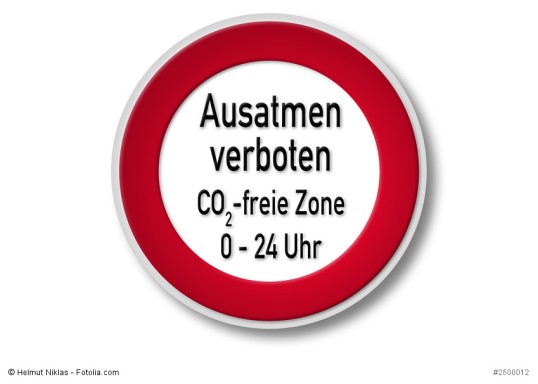- Elektromagnetic Fields
- Indoor workplaces
- Practical Solutions: Ergonomics
- Practical solutions: Hazardous substances
- Practical solutions: Noise
- Practical solutions: Machine safety
- Practical solutions: Personal Protective Equipment
Carbon dioxide

Fictitious "Exhaling prohibited" sign
Source: Helmut Niklas, fotolia
Humans and their breathing are the main source of indoor carbon dioxide (CO2) emissions. However, they do not result in toxically relevant levels of CO2 concentrations even in unfavourable conditions, e.g. where the air exchange rate is low. As odorant substance emissions are usually proportional to humans’ CO2 emissions, CO2 concentration levels are a suitable indicator of indoor air quality provided there are no other sources of CO2 emissions or odours. They also indicate how effective the room ventilation is.
In accordance with the Technical Rules for Workplaces governing ventilation (ASR A3.6), the following reference values apply for evaluation of the carbon dioxide concentration:
-
Carbon dioxide concentration lower than 1,000 ppm:
safe hygiene standard -
Carbon dioxide concentration between 1,000 and 2,000 ppm:
critical hygiene standard -
Carbon dioxide concentration higher than 2,000 ppm:
unacceptable hygiene standard
In accordance with these guide values, ventilation is recommended where the momentary CO2 concentration level exceeds 1,000 ppm. If the concentration level is over 2,000 ppm, ventilation is compulsory. If ventilation is not sufficient to bring the concentration down to below the guide value of 2,000 ppm (a ventilation plan may have to be introduced), further organisational, ventilation-system or structural measures are necessary. These include, for example, reducing the number of people present in the room or installing a ventilation system.
For download

Contact
Hazardous substances: handling, protective measures
Tel: +49 30 13001-3320Fax: +49 30 13001-38001
